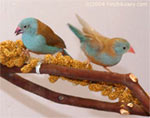How
to Photograph Birds in an Acrylic Aviary (cont)
Camera
Buying Advice for Pet Bird Photography
I
can only offer advice on digital cameras, as I gave up on film
a long time ago (I take way to many bad pictures to be successful
with film). However, some suggestions will apply equally to both.
-
If you can afford it and it meets your needs, go digital. Digital
gives you the ability to take an endless number of pictures
without paying for film or development. This allows you to take
a lot of shots without concern for money. You can throw away
the bad shots (and if you are like me, there will be many) and
keep the good ones. You can also experiment freely with the
different techniques described herein (shutter speed, aperture,
ISO settings, etc) - it won't take you long to learn these things
if you are free to practice a lot. If you want prints and don't
have an archival-quality printer, there are many online digital
processing labs and more and more places now allow you to bring
in your digital pictures for printing.
-
Look for a camera with a high optical "zoom." Digital
zoom means very little - it uses interpolation to enlarge your
image, but image quality degrades. If you want this, you can
do it just as well or better in software. Optical zoom is a
characteristic of the lens and the only type of zoom that is
really worth anything. With a high-powered optical zoom, you
can take close up pictures of your birds from further away.
If you go the SLR route, be sure to budget for a telephoto lens.
-
Look for a camera with a short shutter lag. Shutter lag is the
amount of time between pressing the shutter release and the
camera actually firing. Many digital cameras have shutter lags
of over a second. This means that even if you pressed the release
on time, by the time the camera fires, the bird may have flown
the coop. With shutter lag, you frequently have to anticipate
your shot and fire early, and this is hard to do with birds.
The perfect shot only exists for a fraction of a second - then
its gone.
-
Look for a camera with some manual capability. Even if this
seems intimidating, being able to control depth of field, freezing/blurring
of motion, ISO sensitivity, and other things such as white balance
and exposure compensation can go a long way toward improving
your photographs. And with a digital camera, you can experiment
all you want. Don't worry about being overwhelmed; even the
most sophisticated digital cameras usually have a fully automatic
mode. And many of the consumer-level cameras meant to be used
as automatic point-and-shoots will still have some manual controls
in case you want to experiment.
-
How many megapixels you need depends on your intended output.
For web use, you can get by with a little 2 MP camera. For standard
4x6 prints, you can do well with 2-3 MP. For enlargements of
your prints, you will want 3 or more MP. Keep in mind that the
number of megapixels is not a measure of picture quality, just
how big they can be printed/displayed. Note that, although for
web use you don't need many megapixels, you might want them
anyway if you don't have enough optical zoom on your camera
of choice. With a higher megapixel camera, you can crop a smaller
percentage of the frame and still have a larger, decent-sized
image.
-
Quality counts. Visit these sites for reviews of available digital
cameras: www.steves-digicams.com,
www.dcresource.com, www.dpreview.com.
Click
Previous to go back to Avoid Stressing the Birds
PREVIOUS

 TOP TOP |
|
